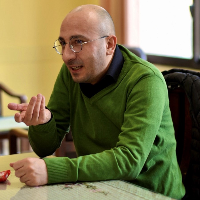Embodiment and Self-Experience in Iranian Cinema: A phenomenological Study of Six Films from the 1980s to the 2010s
Lived experience in the life-world is an interdisciplinary concept, according to which the sociological understanding of films is made possible by a phenomenological approach. In this research, we extended Husserl's life-world notion to the world of films and reached the concept of "the symbolic life world of films". Film is a social production and plays a role in the construction of the social world. Therefore, it can be said that the world of everyday life continues in the world of films as well. In this world, intersubjectivity takes on a symbolic aspect, that is, the characters’ lived experience is expressed in cinematic language. In the symbolic life-world of films and the intersubjective relationships of characters, the themes related to the embodiment and self-experience can be described phenomenologically. The main purpose of this research was to study embodiment and self-experience in the narration and actions of male and female characters in Iranian cinema from the 1980s to the 2010s. The main question was how embodiment and self-experience of the subjects are were constructed in the intersubjective relations.
This research was done with the aim of understanding embodiment and self-experience in the symbolic life-world of films through the method of descriptive phenomenology and thematic analysis. To this goal, 6 Iranian films were selected from the 1980s to the 2010s by using intensity sampling, in which the embodiment and self-experience of the subjects were portrayed as philosophical and problematic ideas as follows: Maybe Another Time, Hamun, Passengers, Unruled Paper, Bright Nights, and Subdued. After selecting the samples, deep observation and coding, as well as other analytical steps, were performed. The key sequences and dialogues of each film were selected and compared after several observations. By replaying and watching the films in slow and fast motions, we were able to obtain the data that might have been overlooked in real observations. Due to the in-text nature of this study, we sought to extract meanings and concepts by coding the internal space of the images. In the theme analysis, we sought the general structure of meaning, not fragmented themes and categories. Therefore, the findings of this study included the themes that showed the general semantic structure and context of the subjects under study.
The results revealed that in the studied films, the characters were in crisis in their interpersonal relationships and thus constructed in the form of self/other duality. This duality was the fundamental form of the subjects’ experiences, in which the self and the other were constructed in the intersubjective realm. The social context, in which the films had been produced over the 4 decades (the 1980s to the 2010s) constituted a specific gender structure.The embodiment of the subjects was constructed in the context of actions and role performances, whether in the form of a female or a male body. The embodiment and self-experience of the gendered subjects were based on a priori patterns in the collective intersubjective space that pitted them in opposition to each other, the most important form of which was confrontation of a man and a woman.The subject experienced himself in the self/other duality and the embodiment was a mediator for self-recovery or transformation in the other. In the 1980's, this duality had an individual form; the female body had no independent domain and was formed in another absurd (male) mental framework. The female body was an object that was extinguished under the gaze of another person and self was recovered by another one. In the 1990s, the self/other duality was drawn into the collective realm and the subjects were constituted in the form of duality of technique/collective intersubjectivity. The body and the self were recovered in the collective intersubjective frame and the nature of the technique was revealed in the forgery of the subjects. In the 2000s, the embodiment of the subjects was drawn into the realm of confrontation/transition; the embodied action of the woman passed through the absurd body of the man and left her in an abandoned world. In the 2010s, this contrast faded and the subjects were constituted in the form of co-embodiment. The collective bond merged with the fast-food physicality and sensitivity of the female body, while the subject experienced herself in the metamorphic form of the house. Contrary to the results of previous researches, which had a fixed and static understanding of the gendered body of the subjects and considered man as the dominant subject and woman as being subjugated to the patriarchal system, the findings of this study conducted through a phenomenological approach showed that the subjects were constructed in the form of a confrontation with each other.The dominant subject (male) in most films was in crisis himself and thus an absurd subject. The woman was also able to face, confront, and find transition from the man through her embodied actions.
- حق عضویت دریافتی صرف حمایت از نشریات عضو و نگهداری، تکمیل و توسعه مگیران میشود.
- پرداخت حق اشتراک و دانلود مقالات اجازه بازنشر آن در سایر رسانههای چاپی و دیجیتال را به کاربر نمیدهد.


